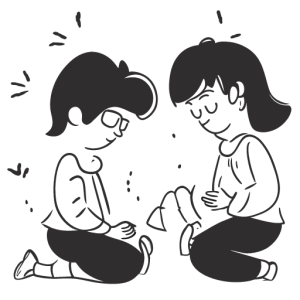Buddhist psychology is an approach to understanding the mind grounded in the teachings of Buddhism. It emphasizes insight through meditative observation, focusing on inner experiences rather than just external behaviors. In essence, Buddhist psychology investigates how our thoughts and emotions work and seeks to uncover what leads to happiness and what causes suffering. Its core principles derive from Buddhist philosophy – including the recognition that suffering is a central part of life and the understanding of impermanence (that all things change) and non-self (that there is no fixed, independent “I”). The ultimate aim is to reduce suffering in the here and now, and ultimately achieve liberation from distress. These principles provide a compassionate, wisdom-based framework that can be applied to many life challenges, including the healing of psychological trauma.
Understanding Trauma Through a Buddhist Lens
From a Buddhist perspective, trauma is understood as an intense form of dukkha, the Sanskrit/Pali term for suffering. The Buddha’s First Noble Truth explicitly acknowledges that suffering — from ordinary stress to profound trauma — is an inherent part of human life. Recognizing this can actually be comforting for trauma survivors: it normalizes their pain as something not personal or “broken” but part of the human condition. In clinical settings influenced by Buddhism, practitioners sometimes remind clients that “you are experiencing the First Noble Truth” — meaning that what they are going through, however painful, is a universally recognized reality. This perspective can reduce feelings of isolation or shame, helping people see that their trauma responses are not unique failures but natural responses to extreme events.
Buddhism also distinguishes between the unavoidable pain of an injury (or traumatic event) and the additional suffering that we add to it through our reactions. This is illustrated in the parable of the two arrows: the first arrow is the painful event itself, and the second arrow is how we respond to that pain. For example, a trauma might be the first arrow, and the subsequent guilt, anger, or self-blame we carry would be the second. Buddhist psychology encourages us to reduce this secondary suffering. In therapy, this means helping individuals not add self-judgment or destructive narratives on top of their pain. By directly addressing these “second arrow” issues — such as the beliefs of shame, worthlessness, or hatred that often follow trauma — one can alleviate a great deal of the total suffering associated with the traumatic experience.
Furthermore, Buddhist teachings note that trauma often shatters our comfortable assumptions about life. We may lose the belief that the world is safe or fair, which is deeply disorienting. While this shattering is painful, Buddhism frames it as an opportunity to see reality more clearly. The Buddha taught that much of our suffering comes from attachment to false views — for instance, the belief that life is always controllable or that bad things “shouldn’t” happen. Trauma forcefully shows us impermanence and uncertainty. Through a Buddhist lens, facing this truth — however extreme — can lead to profound personal growth or insight. In fact, many practitioners find that confronting the extreme dukkha of life can precipitate a breakthrough in understanding. Over time, with support and reflection, a survivor may come to rebuild their worldview on a more realistic foundation, finding new meaning, resilience, and even compassion as a result of their trials.
Mindfulness and Awareness
One of the central tools of Buddhist psychology for healing trauma is mindfulness. Mindfulness (known as sati in Buddhism) is the practice of bringing one’s awareness to the present moment with an attitude of openness and non-judgment. In the context of trauma, mindfulness helps create a safe inner space to gently encounter painful memories and emotions instead of constantly avoiding them. Avoidance is a common response to trauma, but from both a Buddhist and psychological standpoint, avoidance often prolongs suffering. By contrast, learning to mindfully observe one’s thoughts, feelings, and bodily sensations can gradually reduce the fear and power they hold. For example, simply focusing on the rhythm of the breath or the sensations of the body can ground a person when they feel a trauma trigger arising. This here-and-now focus activates the parasympathetic nervous system (the calming part of our physiology) and can bring down anxiety and panic. Therapists trained in mindfulness often teach clients basic breathing or body-scan exercises so they can self-soothe during moments of distress. A survivor who learns to notice “I am feeling anxious” and to calmly ride that feeling like a wave — watching it peak and subside — is less likely to be overwhelmed when intrusive memories surface. In this way, mindfulness builds emotional regulation skills: it gives back a sense of control, as the person realizes they can observe their experience without being swept away by it.
Research supports the healing role of mindfulness. Studies have found that individuals who cultivate higher levels of mindfulness tend to report fewer post-traumatic stress symptoms. Being mindful helps disrupt the cycle of reactivity: instead of instantly panicking at a reminder of the trauma, one can take a slow breath, notice the sensations (perhaps a racing heart or tight chest), and allow them to pass. This doesn’t remove the pain of what happened, but it changes the survivor’s relationship to that pain. Over time, mindful awareness can transform traumatic memories from terrifying flashbacks into manageable recollections — experiences that one can reflect on without collapsing. In practical terms, mindfulness practices (like mindful breathing, meditation, or mindful movement) have been shown to reduce anxiety, depression, and even physiological aspects of PTSD. By training the mind to stay present, Buddhism’s age-old practice helps trauma survivors reclaim the here and now, rather than being yanked helplessly into the then and there of the past.
Compassion and Self-Kindness
Guan Yin, the Bodhisattva of Compassion, symbolizes unconditional empathy for all beings. In Buddhist tradition, compassion (karuṇā) is a powerful force for healing suffering. In Buddhist psychology, compassion — especially self-compassion — is considered essential to recovering from trauma. Trauma often leaves people feeling damaged, self-critical, or full of shame. Cultivating compassion counteracts these tendencies by encouraging a warmer, more forgiving attitude toward oneself. Instead of seeing oneself as “weak” or “broken” for having trauma symptoms, a compassionate approach says: “I am a human being who has lived through pain, and I deserve understanding and care.” This shift in mindset can be profoundly healing. Modern research echoes this ancient wisdom: higher levels of self-compassion are consistently associated with lower levels of PTSD symptoms. When survivors learn to treat themselves with the same kindness they might offer a dear friend, their trauma-related anxiety and depression often diminish. In fact, there is growing evidence that therapies which explicitly cultivate self-compassion lead to reductions in PTSD severity. By softening harsh self-judgment, survivors can begin to feel safe in their own minds again.
Buddhist practices like loving-kindness meditation (Metta) are practical methods to foster compassion. Metta meditation involves sending well-wishes – such as “May I be happy, may I be safe, may I be free from suffering” – first to oneself, then expanding outward to others. For someone healing from trauma, this can be transformative. It gently erodes the sense of alienation and self-loathing that trauma can instill. Repeating kind intentions helps rebuild an inner voice of support. Over time, survivors may start to genuinely feel that they are deserving of love and that others are, too. This opens the door to reconnecting with people and experiencing positive emotions, reversing the numbness or anger trauma often brings. Compassion practices also extend to forgiving or letting go of anger toward those who caused one harm (when appropriate), which can relieve a heavy burden of bitterness. In Buddhist psychology, compassion is not a weakness; it’s a strength that holds pain with tenderness so that it can slowly heal. Therapists inspired by this approach often model compassion in the therapy relationship — listening with unconditional positive regard — to give the survivor a felt sense of what it’s like to be cared for. This “re-parenting” of the hurt self creates the safety needed to process deep wounds. Ultimately, compassion — whether from others, oneself, or a spiritual source — is a balm that soothes the raw edges of trauma, allowing the psyche to recover its balance and wholeness.
Letting Go and Non-Attachment
Another cornerstone of Buddhist psychology relevant to trauma healing is the principle of letting go, or non-attachment. After a traumatic event, it’s natural to hold onto the pain, replaying what happened or clinging to how life used to be. We might also develop a strong attachment to feeling safe and certain, and when that is ripped away by trauma, we suffer immensely. Buddhism teaches that clinging – whether to pleasant experiences we want to keep or to painful experiences through obsessive fear – inevitably leads to suffering, because everything is impermanent. In other words, all things (including our feelings and circumstances) are in constant flux; trying to grip them tightly is like trying to hold onto flowing water. For trauma survivors, the idea of impermanence can actually bring hope. It means that the intense fear or agony they feel right now is not a permanent state – it can change. The past does not have to define the future.
Learning to let go does not mean denying or erasing the trauma. It means gradually releasing the attachments associated with it: the attachment to the identity of being a victim, the attachment to hatred or revenge, or the attachment to the belief that “I will never be whole again.” Buddhist psychology encourages survivors to observe these thoughts and feelings, and to allow them to pass like clouds in the sky. By not clinging to them as absolute truth, one finds that they begin to lose their power. As one Buddhist-oriented therapist noted, “The incorrect belief that things are stuck and will never change results in great suffering… It is only through letting go of the resistance to change and impermanence that true healing and growth is possible.”
In practice, this might involve forgiveness (when ready) or simply a shift in focus from “Why did this happen to me?” to “What can I learn as I move forward?”. It’s a gentle process of loosening the grip of the past. A survivor might start by letting go for a moment at a time – for instance, consciously setting aside their trauma during a meditation session, and resting in the present moment. Over weeks and months, those moments add up.
Embracing impermanence also means recognizing that life still holds change and possibilities. The darkness of trauma is not forever; day by day, things can get a little better. Buddhists often meditate on the phrase “this too shall pass,” reminding themselves that all conditions are transient. Such reflections can alleviate the despair and hopelessness that come with PTSD. When a trauma survivor internalizes the truth of impermanence, they might feel a weight lift – as the quote above illustrates, even a simple reminder that feelings and situations will change can “restore hope”. Instead of feeling mired in pain with no exit, one sees that healing is a journey and that their feelings will evolve. Bit by bit, the person can loosen their attachment to the traumatic story and make room for new experiences. This letting go is profoundly liberating: it doesn’t erase the past, but it releases the tight hold that the past has on one’s present. In Buddhist terms, it’s like untying a knot in the heart. The memories may remain, but they no longer bind the person in the same way. They can breathe again, live again, and even find joy, understanding that change is the nature of life and that new growth is always possible from the ashes of what was.
Practical Techniques for Trauma Healing
Buddhist psychology offers a variety of practical techniques and meditative exercises that trauma survivors can use in their healing journey. Many of these can be done at home or with guidance in a therapeutic setting. Below are some key Buddhist-inspired practices, along with how they help in working with trauma:
- Mindfulness Meditation (Vipassana): This foundational practice involves sitting quietly and focusing on the breath or bodily sensations, while gently bringing the mind back whenever it wanders. For trauma healing, mindfulness meditation helps strengthen one’s ability to stay present. Instead of getting lost in traumatic memories or anxiety about the future, the survivor practices returning to here and now. If painful emotions arise during meditation, they are noted with a compassionate, observing attitude (e.g. “fear is here”) and allowed to dissipate. Over time, this builds a person’s tolerance for discomfort and their confidence that they can handle distressing thoughts without panicking. Even a simple exercise like mindful breathing – inhaling deeply, exhaling slowly while noticing the feelings of air – can soothe the nervous system and interrupt a spiral of traumatic flashbacks. Regular mindfulness practice essentially retrains the brain to reduce automatic reactivity. It creates a calmer baseline and gives a person more pause before reacting, which is invaluable for someone healing from trauma.
- Loving-Kindness Meditation (Metta): In loving-kindness practice, one intentionally generates feelings of warmth and kindness. The meditator repeats phrases such as “May I be safe. May I be happy. May I be healthy. May I live with ease.” They start with themselves, then extend these wishes to others — including loved ones, neutral people, and even those they have conflict with. For trauma survivors, Metta meditation is a way to rebuild an inner atmosphere of safety and love. It counteracts the self-blame and mistrust that trauma often breeds. By regularly sending kind wishes to themselves, survivors nurture self-compassion and break down the walls of numbness around the heart. This practice has even been tested scientifically: A 12-week course of loving-kindness meditation for veterans with PTSD led to significant reductions in symptoms of PTSD and depression, and greatly increased self-compassion. In fact, one study found that loving-kindness meditation was as effective as standard cognitive therapy for treating PTSD in combat veterans. This gentle practice can be done in just a few minutes a day, and its positive emotions help replace the fear and anger left by trauma with feelings of care, connection, and hope.
- Compassion Meditation and Self-Compassion Exercises: Beyond general loving-kindness, there are specific meditations to cultivate compassion for suffering parts of oneself and others. One example is the “Tonglen” practice taught in Tibetan Buddhism: breathing in the pain (in a symbolic sense) and breathing out relief or compassion. A trauma survivor might, for instance, breathe in a feeling of sorrow and breathe out comfort to that feeling, imagining it like a dark smoke transformed into light. This trains the mind to approach pain with tenderness instead of fear. Another practical tool used in therapy is the self-compassion break (inspired by Buddhist principles and developed by psychologists): in a moment of difficulty, you pause and say to yourself, “This is a moment of suffering. Suffering is a part of life. May I be kind to myself in this moment.” Such phrases echo Buddhist teachings (acknowledging universality of suffering and the importance of compassion) and help to directly soothe emotional overwhelm. By practicing self-compassion, survivors create an inner caregiver to counter the inner critic or the sense of aloneness. This makes it much easier to face traumatic memories because one part of the mind is actively providing comfort to the part that is afraid. Compassion meditations can also involve visualizations – for example, envisioning a compassionate figure (like the Buddha, Jesus, Quan Yin, or even a loved one) offering you protection and love. This can rewire the brain’s associations, gradually replacing terror and hurt with comfort and safety.
- Grounding and Body Awareness Practices: Trauma can cause dissociation – a feeling of being disconnected from one’s body or the present moment. Buddhist psychology has long emphasized awareness of the body as a way to anchor the mind. Practices like the body scan meditation systematically move attention through the body from head to toe, noticing sensations in each region. This helps trauma survivors re-inhabit their bodies gently, learning to detect areas of tension or emotion and relax them. Walking meditation is another useful technique: the person walks slowly and deliberately, coordinating breath with steps, and focusing on the feeling of the feet touching the ground. This is very grounding and can pull someone out of a swirling mind-state into a calmer, embodied state. Even simple mindful movement or stretching (drawing from yoga or qigong, which align with Buddhist mindfulness principles) can release trauma-related stress stored in the muscles. The key is the attitude of non-judgmental awareness: moving or scanning the body while treating whatever arises (trembling, aches, etc.) with gentle acceptance. Such practices teach survivors that it’s safe to be in their bodies again. They also emphasize that right now, in this moment, one is actually safe – a powerful realization for someone whose body has been conditioned to expect danger. Grounding techniques drawn from Buddhism often become go-to coping skills whenever trauma symptoms flare up; for example, a few minutes of mindful breathing or walking can help a survivor come back to the present if they start to feel a panic attack or dissociative episode coming on.
These techniques can be customized to the individual and should be approached gradually. It’s often recommended that trauma survivors learn these practices with a qualified teacher or therapist, especially early on, because diving into meditation can sometimes bring up strong emotions. A trauma-sensitive approach to Buddhist practices will emphasize short sessions, options to open one’s eyes or stop if overwhelmed, and activities that build a sense of safety first. With proper guidance, however, these Buddhist-inspired techniques become reliable tools in a survivor’s toolbox. They empower individuals to take an active role in their own healing — practicing mindfulness or compassion exercises each day to strengthen their mental well-being, much like one might do physical therapy exercises to rehabilitate an injury. Over time, these small daily practices accumulate, leading to big changes in how a person relates to their trauma and to life in general.
Modern Applications in Therapy and Trauma Recovery
In recent decades, Western psychology and medicine have increasingly integrated Buddhist psychology principles into modern trauma therapy programs. What was once ancient wisdom is now being validated by scientific research and adapted into clinical practice. A prime example is the rise of mindfulness-based interventions. Programs like Mindfulness-Based Stress Reduction (MBSR), developed by Jon Kabat-Zinn, introduced mindfulness meditation into mainstream healthcare and have been used to help trauma survivors manage stress and PTSD symptoms. Likewise, Mindfulness-Based Cognitive Therapy (MBCT), originally designed for depression, incorporates mindfulness practices to prevent relapse and has been applied to individuals with trauma histories to help them observe painful thoughts without getting caught up in them. Therapies such as Dialectical Behavior Therapy (DBT) and Acceptance and Commitment Therapy (ACT), which are widely used for conditions often rooted in trauma (like borderline personality disorder or complex PTSD), heavily draw on mindfulness and acceptance strategies straight out of Buddhist practice. Patients learn skills like observing their emotions, radical acceptance of reality, and staying grounded in the present — all of which echo Buddhist teachings.
Another area of integration is compassion training in therapy. Compassion-Focused Therapy (CFT), developed by psychologist Paul Gilbert, explicitly uses practices of compassion (many inspired by Tibetan Buddhism) to help people with high self-criticism or trauma-related shame. In CFT and similar approaches, clients might be guided in imagery of compassionate figures or encouraged to cultivate loving-kindness daily, directly applying Buddhist techniques to heal psychological wounds. This approach recognizes, as Buddhism does, that self-blame and shame often maintain trauma symptoms, and that building self-compassion can break that cycle.
Even traditional trauma therapies have begun to incorporate Buddhist elements. For example, some therapists use metta meditation or breathing exercises at the end of EMDR (Eye Movement Desensitization and Reprocessing) sessions to help clients calm and integrate positive feelings. There are also specialized programs like the MET(T)A Protocol, which is a treatment template combining mindfulness meditation with EMDR for trauma and addiction. In the MET(T)A Protocol, clinicians teach not only basic mindfulness, but also elements of the Buddhist Eightfold Path (such as fostering ethical intentions and compassionate understanding) as part of recovery. This holistic approach highlights the innate wisdom within clients – the idea (rooted in Buddhist thought) that deep down, each person has an untouched core of sanity and strength, no matter how much trauma they’ve endured. By affirming this “inner Buddha” or inner resilience, modern therapies give survivors a powerful message: that they are not forever defined by what happened to them, and that within them are the seeds of healing.
The influence of Buddhist psychology in trauma treatment is also evident in the growing body of research supporting these methods. Reviews and meta-analyses have found that meditation and mindfulness practices can lead to significant improvements in PTSD and trauma-related symptoms. For instance, studies on veterans have shown that meditation programs (whether mindfulness-based or loving-kindness) result in reduced flashbacks, improved mood, and better stress tolerance. In some trials, as noted earlier, meditation-based treatments performed on par with gold-standard therapies for PTSD. These findings are encouraging mainstream clinics and veterans’ hospitals to offer meditation classes, yoga, or tai chi alongside talk therapy and medication. The U.S. Department of Veterans Affairs, for example, has developed protocols for mindfulness meditation groups and has conducted randomized trials on loving-kindness meditation for PTSD with positive outcomes. At the same time, many trauma therapists now undergo mindfulness training themselves, seeing the value of being fully present and grounded when working with clients who have experienced severe trauma.
It’s important to note that the modern integration of Buddhist psychology is typically done in a secular, trauma-informed way. This means the practices are taught as mental health skills, not religious rituals, and they are adapted to be sensitive to the needs of trauma survivors. Someone does not need to be Buddhist or adopt Buddhist beliefs to benefit from these approaches – the tools work across cultures and beliefs. However, the ethical and philosophical depth of Buddhism is often there in the background, providing a gentle framework. Clinicians might encourage qualities like non-judgment, patience, beginner’s mind, trust, non-striving, acceptance, and letting go (which Kabat-Zinn identified as attitudinal foundations of mindfulness, all parallel to Buddhist virtues). These qualities create a therapeutic atmosphere where healing from trauma can unfold naturally.
In summary, what we are witnessing is a convergence of ancient and modern wisdom. Buddhist psychology, with its 2,500-year-old insights into suffering and liberation, is enriching contemporary trauma therapy by offering effective techniques and a compassionate outlook. Whether it’s through a mindfulness app used by a trauma survivor each morning, a therapist leading a client in a loving-kindness visualization, or a support group reflecting on impermanence and resilience, the principles of Buddhist psychology are helping people transform their relationship with trauma. This integration represents a powerful alliance: the rigor of evidence-based Western therapy with the depth of Eastern contemplative practice. For many survivors, it means having more tools and avenues to reclaim their lives from the grip of trauma.
Buddhist psychology provides a profound yet practical approach to working with trauma. It reminds us that while pain in life is unavoidable, suffering can be understood and eased. By viewing trauma through a Buddhist lens, we learn that we are not alone in our suffering and that our reactions to pain are natural — and more importantly, changeable. Mindfulness teaches the survivor to face and befriend their experience in the present moment, rather than running from it. Compassion fosters a nurturing inner voice that can hold one’s pain with love and patience. The principle of impermanence assures us that no matter how heavy the darkness feels, it will not last forever and that healing and growth are possible. These insights, combined with concrete practices like meditation and loving-kindness, offer a pathway to gradually release the grip of trauma.
Modern therapy’s embrace of Buddhist practices has only reinforced what practitioners have known for ages: the mind possesses an incredible capacity to heal itself when given the right tools and conditions. Buddhist psychology contributes many of those tools — from breath awareness to compassionate reflection — and creates conditions of acceptance and wisdom that allow deep wounds to mend. The key takeaway is that recovering from trauma is not about forgetting or fighting our past, but about changing our relationship to it. As the Buddha taught, by understanding the nature of suffering, we can find freedom from it. In practical terms, this means with mindfulness we learn to tolerate and release painful feelings, with compassion we learn to love and integrate the parts of ourselves that hurt, and with insight we learn to let go of the debilitating stories we tell ourselves.
Buddhist psychology doesn’t replace other trauma treatments but rather complements them, adding a spiritual and philosophical dimension to the healing process. It speaks to the human spirit in trauma recovery, not just the symptoms. In the end, the integration of Buddhist principles into trauma work offers a message of hope: No matter how deep the wound, healing is possible. By turning inward with awareness and kindness, we can gradually transform suffering and rediscover peace. The journey may be long and challenging, but with guidance from both ancient wisdom and modern science, trauma can become not only a story of pain, but also a story of resilience, meaning, and even compassion. That is the heart of Buddhist psychology’s gift to trauma recovery — the knowledge that within every individual lies the potential to awaken from suffering into a life of greater freedom and wholeness.
References: Buddhist psychology concepts and their therapeutic applications have been drawn from traditional teachings and supported by contemporary research. Key insights on mindfulness and trauma integration are supported by findings that mindfulness practice correlates with reduced PTSD symptoms and improves emotional regulation in trauma survivors. The role of compassion is highlighted by studies showing higher self-compassion is linked to lower PTSD severity and that compassion-based interventions can facilitate trauma recovery. The importance of impermanence and letting go in healing is discussed in Buddhist literature and echoed by clinicians, noting that accepting change can alleviate hopelessness and catalyze recovery. Practical techniques like loving-kindness meditation are backed by research demonstrating their efficacy for PTSD (e.g. veterans practicing Metta had significant symptom reduction). Finally, the integration of Buddhist psychology into modern trauma therapy is evidenced by numerous mindfulness-based programs and clinical trials, which affirm meditation and yoga as effective complementary treatments for trauma and PTSD, and innovative protocols that weave Buddhist principles (such as innate compassion and wisdom) into therapy frameworks. These sources reflect a convergence of ancient wisdom with modern science in the ongoing effort to heal trauma.







